1989 Mexican Grand Prix race report
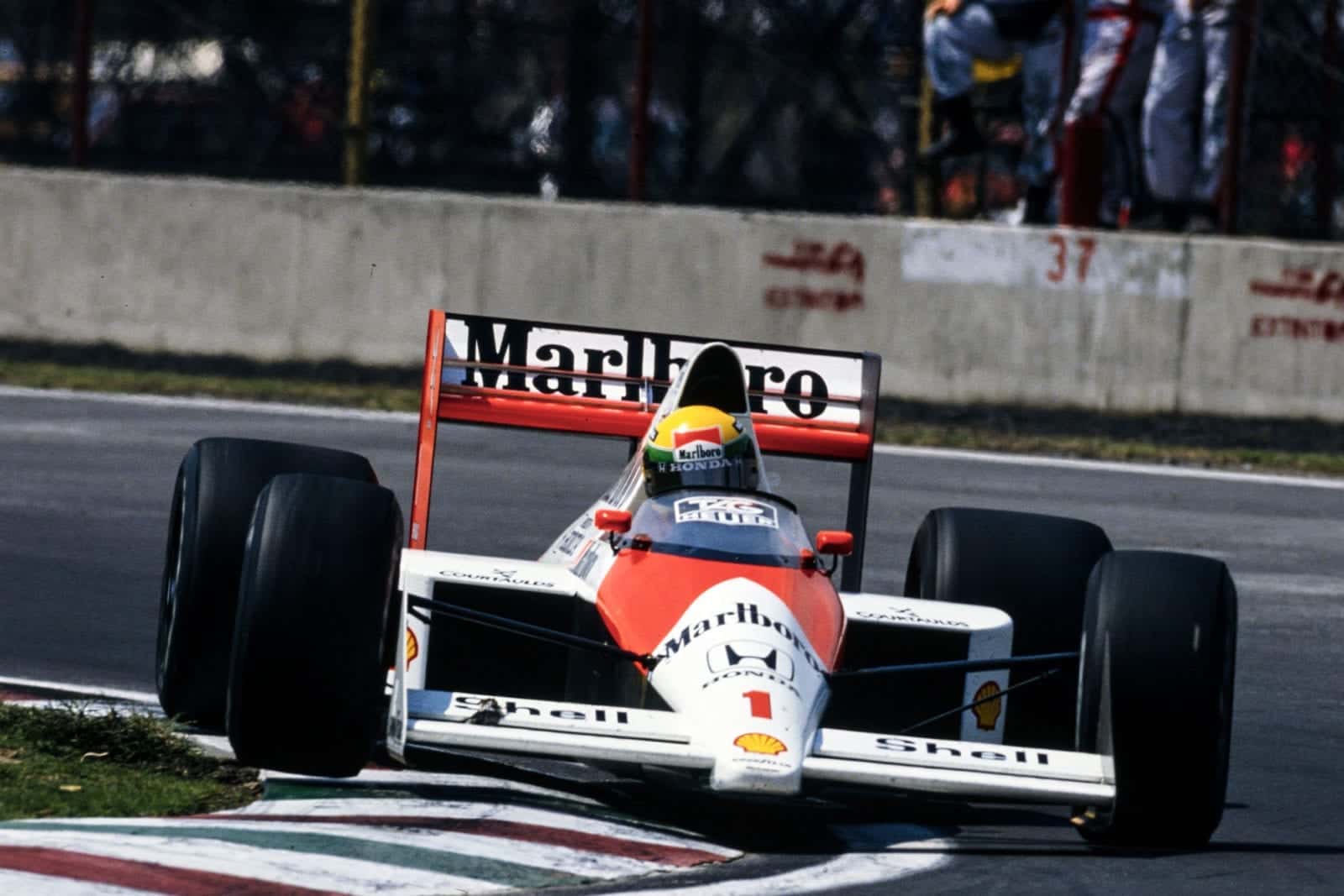
Ayrton Senna took a third win in four races for McLaren
Motorsport Images
Warning siren
The power of Honda’s RA109E was ultimately Alain Prost’s downfall in the Mexican Grand Prix on May 28. That, and a gamble on tyre choice that didn’t come off. Throughout qualifying round the Autodromo Hermanos Rodriguez the Frenchman had stayed close to team rival Ayrton Senna. The Brazilian had been faster in both of Friday’s sessions as Prost rued his choice of front springs and dampers for this notoriously bumpy venue. Then on Saturday morning Alain topped the times. By the afternoon, however, Senna put in his familiar blast to beat him, not by the tenths that had became usual prior to Monaco, but by a massive nine-tenths of a second.
Prost filed that away in his mental notebook, which had already been throwing up data from the mid-part of 1988. Something felt wrong, and his warning sirens were sounding the way airliner’s do when it is about to stall. When he topped the race-morning warm-up, from Mansell and Senna, he felt better, but knew he would have to do something special about Ayrton.
In 1986, despite running on only five cylinders for most of the race, Prost had finished the Mexican Grand Prix in a brilliant second place. Gerhard Berger had won after a cunning non-stop run for Benetton and Pirelli as the Goodyear runners floundered. Title aspirants Piquet and Mansell, and Senna, had each made two tyre stops. The canny Prost, however, had made it through on two sets and thus only one stop. He couldn’t catch Berger but he did beat his main rivals, and the drive duly went a long may towards helping him retain his world title.
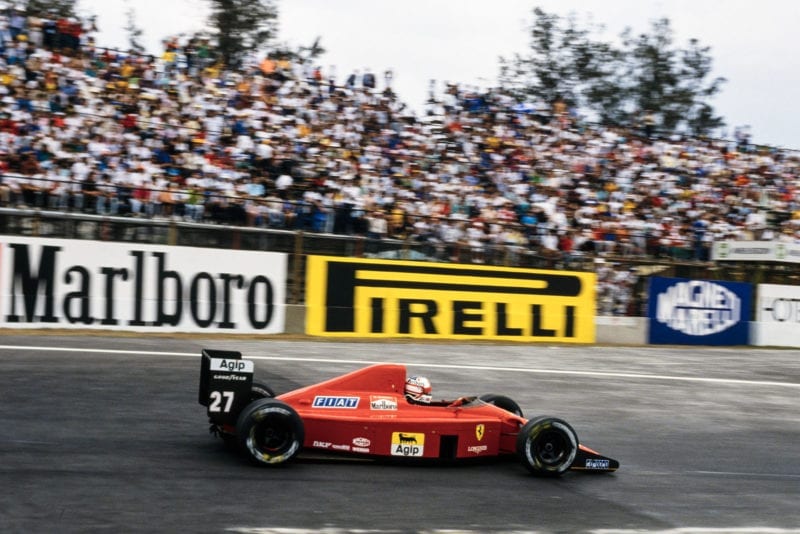
In qualifying Nigel Mansell was the closest challenger to McLaren
Motorsport Images
Now, in 1989, he believed a tyre gamble was worthwhile. Of course, the choice between Goodyear’s more durable B compound and its softer C race tyre was a matter of great secrecy immediately before the 61-lap race. Senna was guided by his crew: Bs on the left, Cs on the right. Prost was advised to go for the same, but opted instead for the Cs all round. Further down the pit road, Ferrari was bolting Cs to its two F1/89s (in one of which Berger had returned to stymie Cesare Fiorio’s plans to run the Italian Osella pilot Nicola Larini). In the Williams camp, Bs all round were the enforced order of the day if it was to avoid pit-stops. For Tyrrell, surprisingly competitive here, it was Cs.
In the opening laps Prost was all over Senna, pushing here, thrusting there, always hoping that he might make a mistake or overcook his tyres. The game of cat and mouse lasted until lap ten, by which time Ayrton’s Bs had come in fully and the World Champion was able to run hard. “I made sure I always got Peralta right,” he said, referring to the vitally important 180° slightly banked right-hander before the pits. “That way I knew Alain couldn’t get close enough to pass.” Prost, meanwhile was hearing those warning sirens again, on two fronts. With his softer tyres he knew he should have been better able to challenge Senna in those opening laps. When he couldn’t, when he watched time and again on the straight as his team-mate pulled away, he began thinking back to the middle of 1988, when his MP4/4 had lacked the pace it had shown in winning the French Grand Prix at Paul Ricard.
Read his book, written with French journalist Jean-Louis Moncet, and he makes it clear he had to get very angry with McLaren and Honda before he felt his equipment was the equal of Senna’s. At the time, Honda had vehemently denied any favouritism, but Prose took in what Keke Rosberg had told him about his final days with Williams, and what Mansell had at times felt in 1986 and 1987. And Prost being Prost and therefore honest, he came flat out with it after Mexico and declared his feeling that Senna had been given a better engine. Ron Dennis immediately countered that his two drivers choose engine allocation numbers from a hat. Honda’s response came days later, as the field gathered again in Phoenix. As an observer you believe whom you want to believe, but the fact remained that Prost was most unhappy, and that unhappiness might ultimately drive him to another team. .
And to compound what he already felt about his engine, he began to sense his front left C blistering as the gap opened from 0.7 seconds on lap six to 4.01 seconds eight laps later. Moreover, tyre pressures had risen with the increased temperatures, and thrown out the handling. On lap 20 he pitted for fresh rubber, expecting B lefts and C rights after radio consultation. Instead by mistake he got a C left rear which also blistered, and he was back after another 14 laps to have it exchanged for the right compound.
By then it was too late. Far too late. Senna was away up that bumpy road heading for a 17th Grand Prix victory that was both deserved and faultless.
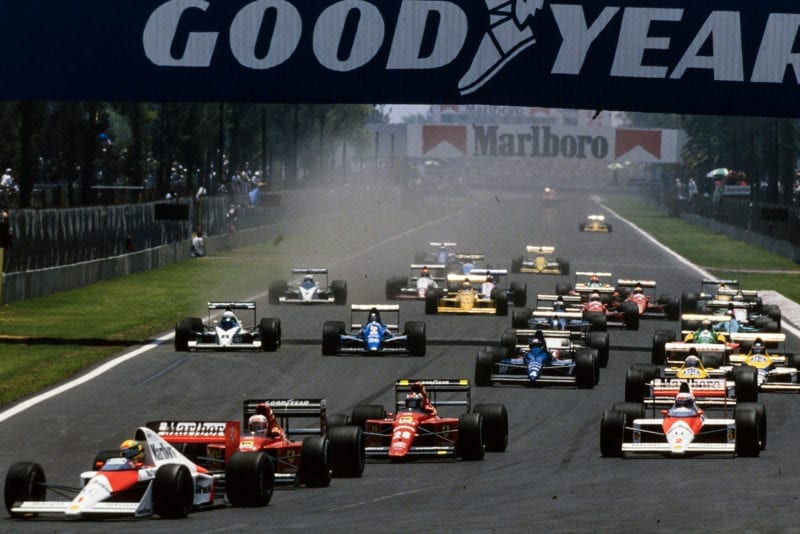
Senna takes the lead at the start
Motorsport Images
Last year he had spoiled his start; this time, even though a spin by Stefano Modena had obliged the original start to be abandoned and the race to be restarted half-an-hour later, he made two perfect getaways from the record-matching 33rd pole position of his career. Four races into the season, he looked unbeatable.
Both Ferraris ran well, Berger initially running third ahead of Mansell after the fast-starting Briton had lost momentum when Prost passed him on lap one, and though the brave Austrian retired early with gearbox failure, having proved himself fit enough to fight, Mansell looked set at last to add to his points tally. John Barnard’s Ferrari was using its tyres well, and Mansell set the race’s fastest lap as late as the 41st tour. On the face of it, it was using its chassis better than the McLarens, but the latter was running vastly more downforce thanks to what Mansell rated as up to 70 bhp greater grunt at the bottom end of the Hondas’ power curve — it was that downforce which hurt Prost’s Cs.
Mansell looked smooth and comfortable as he pressured Senna enough from a position ten seconds adrift — not quite close enough to be a real threat, but nevertheless a definite contender should anything happen to McLaren No 1. McLarens don’t often retire, though, and Ferraris still do as this stage. On lap 44 for the third time this year, Mansell ground to a halt when his gearbox seized, apparently, according to Cesare Fiorio, when its oil leaked out.
What was bad news for Ferrari was good news for Williams. In the early stages both Riccardo and Thierry Boutsen had run nose-to-tail in fifth and sixth, but just before Berger fell out the Belgian’s car came to a halt with total electrical failure. Exactly the same thing had bought Patrese to a stop just after Friday’s free practice session got underway, but on race day his FW12C didn’t miss a beat. On its Bs it wasn’t in a position to push Senna but Riccardo’s progress was smooth and unruffled, his fastest lap only eight-tenths off the Brazilian’s. Second place was, at last, a belated reward for his performances earlier in the season.
Third place for Michele Alboreto was also a just desert for the Italian and Ken Tyrrell. This time last year Uncle Ken couldn’t even squeeze one of his gripless 017s into the race, but twelve months on he has not only grasped the bull by the horns but, dammit, is wrestling the beast strongly. It may not yet be grounded but it’s down on its front knees. It was Jonathan Palmer who set the ball rolling for the still sponsorless team (did I hear someone say Camel for 1990, or even sooner?) by setting fifth quickest time in both Friday sessions as he exploited Jean Claude Migeot’s aerodynamics to the full. Harvey Postlethvvaite’s elegant chassis had a touch more understeer than the Briton wanted, but on Saturday morning he had just set fastest time when one of the many bumps in Peralta caught him out and threw the 018 into the tyre wall. Damage was superficial, but it spoiled Palmer’s afternoon qualifying effort by upsetting the handling, and it was thus Michele in seventh grid place who represented the team’s best hope. He was always close to Patrese, always looked comfortable, and nearly always had his foot planted to the floor through Peralta; his chassis was that good. It was only towards the end that he began to ease back slightly, and then only because his engine was tired after doing all of qualifying as well. With a decent budget that wouldn’t have happened, of course.
Palmer was well stoked for a strong run from his unrepresentative 14th on the grid, but his impressive progress was cut short after only ten laps when the throttle linkage broke. His time will come. If Ken Tyrrell looked slightly bemused immediately afterwards as the champagne corks popped, he had every right to, for Alboreto’s third was the team’s best result in years. More than that, however, it is an indication that Team Tyrrell is very far from a spent force despite its 1988 record …
The Mexican Grand Prix was a basically dull affair, but there were nonetheless plenty of interesting vignettes. At Benetton they were whistling to keep their spirits up in the face of the new Ford V8’s harmonic vibration problems which had snapped crankshafts and prevented the quick new B189s from making their scheduled debut appearance, but Sandro Nannini at least managed to salvage three valuable points after a steady drive in the overweight B188. Team-mate Johnny Herbert was within tenths of his times all weekend, in a welcome upturn in his fortunes, but was thrown out of any contention by the loss of fourth, then third, gear early in the race.
Derek Warwick also lost third, on the second lap, and was thus handicapped as he fought to keep his Arrows A11 ahead of Gabriele Tarquini’s threatening AGS for the first 35 laps. The Briton had battled against appalling handling over the bumps throughout qualifying, but seemed likely to take a point for sixth when his electrics cut out on lap 36. Tarquini thus sped on to take AGS’s first proper points of 1989 at a time when re-assessment of pre-qualification requirements is getting closer. After Silverstone FISA will assess each team’s performances in the last half of 1988 and the first half of 1989, and decide who still has to prequalify and who no longer does.
Ligier, having somehow avoided prequalification for 1989, had another solid result with Olivier Grouillard’s eighth, earned despite the difficulty of changing gear without a clutch from the eighth lap. Once again the Frenchman proved his maturity with a controlled drive that brought him home within six seconds of Eddie Cheever. As usual, the American had an appalling time qualifying and scraped in 24th, but his drive from there to seventh at the flag was sufficient reminder that a racer’s heart beats within his USF&G overalls.
What made Grouillard’s performance all the more worthy was the persistent pressure he came under from the Brabhams of Brundle and Modena. Both were bog-slow on the straight, and Brundle’s nearly cooked its Judd by the finish despite the triangular cooling slots cut in its sidepods to alleviate the problem after the first aborted start. For some reason which the team couldn’t fathom, the Briton’s car was plagued with high temperatures all weekend, hampering his qualifying efforts.
Modena, meanwhile, though relatively untroubled on his way to ninth fastest grid time, was down in the low groove into Peralta on lap one and lost it, spinning sideways into the tyre wall as Grouillard tapped the front of his BT58. He raced the spare, which he rated a long way beneath his race car.
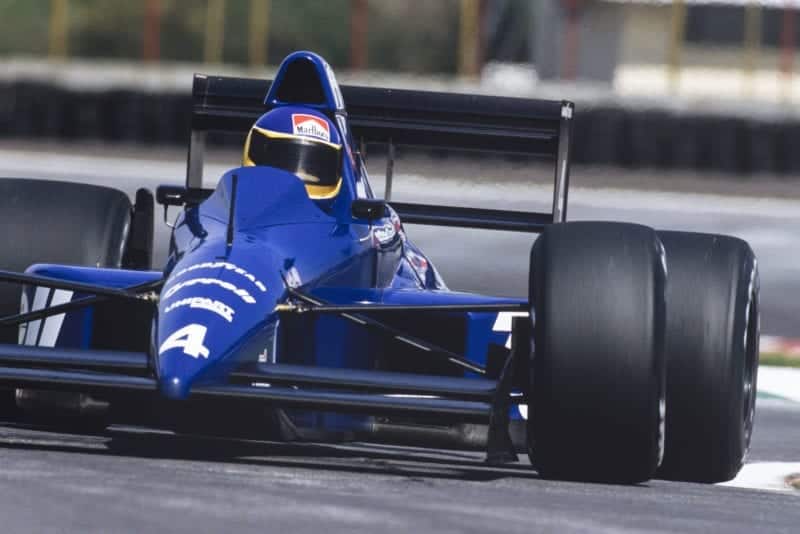
Michele Alboreto finished a commendable 3rd for Tyrrell
Motorsport Images
Like Brabham, Dallara had impressed in Monaco, but in Mexico initial promise was blighted early. Alex Caffi had too much brake bias to the rear and spun at the end of the pit-straight on lap two while trying to pass Modena. Thereafter his handling was awry and his drink bottle pipe detached, so he battled his dehydrated way home 13th, behind Christian Danner in the reliable if unspectacular Rial.
De Cesaris was initially challenging Tarquini for eleventh but a brush with Alliot in the first start had unsettled his chassis, and after a pit-call for inspection he eventually retired with low fuel pressure. Alliot himself, in the sole Lola to qualify, had a nightmare run with an engine that continually cut out. After a series of lengthy stops the Larrousse team was grateful to trace the fault in time for Phoenix; the ignition sensor on the Chrysler Lamborghini’s flywheel was faulty.
After his disappointment at Monaco, Satoru Nakajima was relieved to qualify on the kind of fast circuit he likes. The Japanese may be a journeyman, but to his credit he tried hard and put his Lotus 101 fifteenth on the grid and as high as twelfth in the race, before a brief brush with Brundle, a quick touch in Peralta with Mansell as he was being lapped, and a series of frights with third gear jumping out. It did it once too often on lap 36, and he ended his day in the wall.
And his team-mate? Former triple World Champion Piquet scraped in 26th after qualifying problems with engines and damaged undertrays, nearly stalled at the first start, and “raced” home to an uninspiring eleventh with a sheared damper. The weekend bought the first indications that Camel may not stay with Lotus next year, and a giant question mark must hang over Piquet’s future, not just with Lotus but with Formula One itself.
If the Brazilian represents all that is bad about drivers who lack motivation, Ivan Capelli epitomises all that is good in those who don’t. All through Friday he struggled to get his new Leyton House March CG891 dialled in, but then sprang to prominence with fourth-fastest time on Saturday afternoon, expressing himself very much happier with its balance and performance.
Sadly, he damaged a brake pipe on his race car in an off at Peralta in the first start, and was obliged to take over Mauricio Gugelmin’s car which the Brazilian had been unlucky not to qualify after a series of set-up dramas on Saturday afternoon. The car had to be tailored for Ivan as the race was restarted and he missed the warm-up lap. Starting from the pit-lane, he managed only a lap before an inner constant-velocity joint broke on one of the driveshafts, and his promise was unfulfilled.
There was one final glimmer, and many were genuinely pleased when Stefan Johansson at last pre-qualified his Moneytron Onyx, even if it meant he bumped team-mate Bertrand Gachot (who did an excellent job on his first acquaintance with the track) in doing so. Since their testing at Paul Ricard, Mike Earle’s cars have found a lot more pace, but even so eyebrows were sky-rocketing when the Swede was sixth-fastest right behind Capelli on Saturday morning.
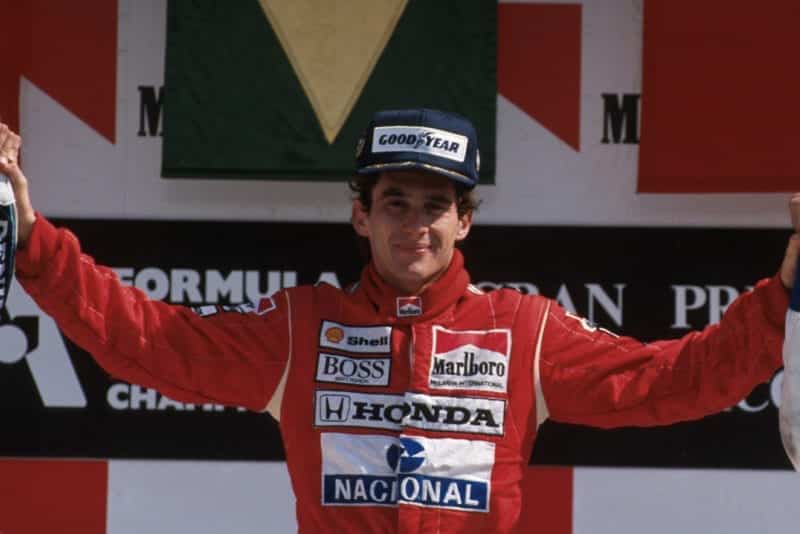
Senna celebrates on the podium
Motorsport Images
In the race itself, he charged from 21st grid place to 17th on the first lap, then picked off his rivals one by one until he was on Tarquini’s tail fighting for ninth by lap 16. Above anything he desperately wanted a finish, and reckoned he was on for a possible fourth as he was catching Nannini at half a second per lap, but the next time round the clutch packed up. It was a fine showing from the new team, spoiled by a reminder that Grand Prix racing isn’t always a fair business. That was probably something that Alain Prost was also thinking, as he headed for Phoenix and the inevitable political storm his post-race comments had aroused. DJT
